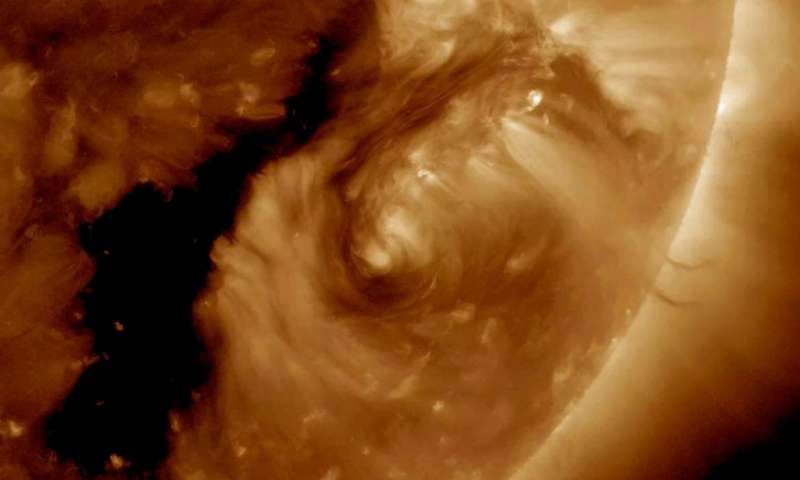
An orbiting NASA observatory spotted a rare phenomenon that scientists have only witnessed a limited number of times: an "encircling filament" near the Earth's sun, according to Space.com.
Sometime between October 29 and 31, the Solar Dynamics Observatory (SDO) spotted the filament, which is a cloud containing many particles that hang above the sun. Although filaments aren't rare, this one stood out to scientists because of its shape.
"Only a handful of times before have we seen one shaped like a circle," NASA officials wrote in a statement.
Typically, solar filaments are long and uneven. The image of the rare sight—which was released by NASA on October 8—was "taken in a wavelength of extreme ultraviolet light," according to the space agency.
In the photo, a black region is also visible and is identified as a coronal hole, which is found in areas where the sun's corona is dark. Coronal holes—first discovered by X-ray telescopes above Earth's atmosphere—are known to produce high-speed solar wind.
The latest findings are part of NASA's SDO mission, which aims to learn more about the sun, particularly its energy and atmosphere.
"By better understanding the sun and how it works, we will be able to better predict and better forecast the 'weather out in space' providing earlier warnings to protect our astronauts and satellites floating around out there," NASA explained.
SDO is unique because it captures enormous amounts of data each and everyday. "In fact SDO will produce enough data to fill a single CD every 36 seconds," NASA said.
In addition to capturing the latest rare oddity, SDO captured two powerful flares in early September, one of which was one of the most powerful in more than a decade, CTV News reported.
The Solar Dynamics Observatory watches the Sun in 10 wavelengths on a 12-second cadence, helping scientists track dynamic events on the Sun. Here, it captured two powerful flares on Sept. 6: an X2.2 and the X9.3 also shown above. pic.twitter.com/jx0qNvHnic
— NASA Sun & Space (@NASASun) November 9, 2017
As a whole, September was an exciting month for NASA solar research. Other satellites operated by the agency captured exciting activity, including "31 sizable solar flares and several coronal mass ejections in just five days," according to a tweet by NASA.
September was 🔥 on the Sun! It released 31 sizable solar flares and several coronal mass ejections in just 5 days. We and our partners are always watching the Sun, so we saw these events from several perspectives. Thread 👇 pic.twitter.com/MVrYXLx7DQ
— NASA Sun & Space (@NASASun) November 9, 2017
Uncommon Knowledge
Newsweek is committed to challenging conventional wisdom and finding connections in the search for common ground.
Newsweek is committed to challenging conventional wisdom and finding connections in the search for common ground.
About the writer
To read how Newsweek uses AI as a newsroom tool, Click here.








